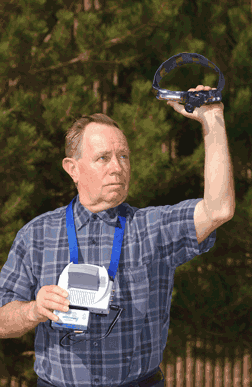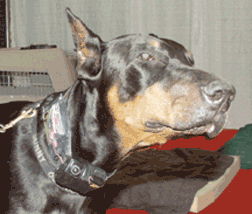FOR IMMEDIATE RELEASE
February 19, 2002
Sandia explores K-9 collar camera kits for
hostage rescue, emergency response
|

Sandia National Laboratories researcher Richard Sparks examines a K-9 collar camera and TV video monitor/receiver kit he is evaluating for law enforcement and search and rescue operations as part of a project sponsored by the National Institute of Justice. (Photo by Randy Montoya)
Download 300dpi JPEG image, ‘collarcam.jpg’, 1.2MB (Media are welcome to download/publish this image with related news stories.)
|
ALBUQUERQUE, N.M. — Sandia National Laboratories is exploring the possible use of tiny cameras that attach to a dog’s collar and, via radio signals that travel through walls to a hand-held TV screen, give police officers and emergency responders K-9 vision from safer positions.
Sandia began evaluating the wireless video cameras and hand-held video receivers in April 2001 as part of a National Institute of Justice-funded (NIJ) project to assess whether K-9 cameras could assist police SWAT teams during hostage negotiations and rescues by providing video intelligence of a scene.
The project was inspired in part by the April 1999 Columbine High School attack, when officers lacked the reliable information they needed to safely enter school buildings.
But the K-9 camera/receiver kits got a surprising real-world test in September 2001.
Shortly after the World Trade Center collapse, NIJ project officials contacted Sandia to see whether the kits could be deployed rapidly to aid the Federal Emergency Management Agency’s (FEMA) Urban Search and Rescue (US&R) teams as they scoured the rubble for survivors.
Sandia project leader Richard Sparks spent 22 days at the site helping the US&R teams outfit their search dogs with the cameras and radios attached to special collars carried by the dogs. The kits were in use essentially 24 hours a day for several weeks.

Search dog at Ground Zero following the Sept. 11 collapse of the World Trade Center is fitted for a TV camera and transmiter. (FEMA photo)
|
|
The real-life situation provided valuable information about the K-9 cameras’ potential uses not only in law enforcement, but also in emergency response, and helped suggest needed improvements, says Sparks.
“There appears to be great interest in the K-9 cameras by many search and rescue teams across the country, especially in California, where the potential for collapsed buildings due to earthquakes is possible,” says Sparks.
Sandia is a multiprogram laboratory operated by Sandia Corporation, a Lockheed Martin Company, for the United States Department of Energy under contract DE-AC04-94AL85000. With main facilities in Albuquerque, N.M., and Livermore, Calif., Sandia has major research and development responsibilities in national security, energy and environmental technologies, and economic competitiveness.
News media contact: John German, jdgerma@sandia.gov, (505) 844-5199
|
